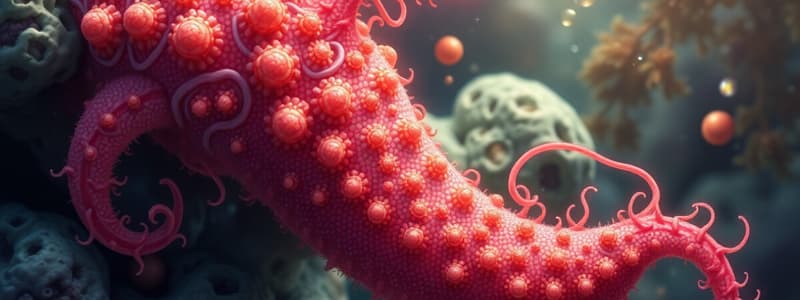Podcast
Questions and Answers
What type of digenetic trematode is known as a liver fluke?
What type of digenetic trematode is known as a liver fluke?
- Schistosoma
- Fasciola (correct)
- Clonorchis
- Dicrocoelium
Which of the following is categorized as a blood fluke?
Which of the following is categorized as a blood fluke?
- Echinococcus
- Hymenolepis
- Schistosoma (correct)
- Fasciola
Digenetic trematodes are organized by their location in the host. Which of the following groups correctly includes intestinal flukes?
Digenetic trematodes are organized by their location in the host. Which of the following groups correctly includes intestinal flukes?
- Paragonimus
- Clonorchis (correct)
- Fasciola
- Schistosoma
Which type of digenetic trematode is NOT classified as a hepatic or liver fluke?
Which type of digenetic trematode is NOT classified as a hepatic or liver fluke?
What is the primary classification method for digenetic trematodes?
What is the primary classification method for digenetic trematodes?
What is the primary intermediate host of Taenia saginata?
What is the primary intermediate host of Taenia saginata?
Which of the following accurately describes the length of Taenia solium?
Which of the following accurately describes the length of Taenia solium?
What is the final host for both Taenia saginata and Taenia solium?
What is the final host for both Taenia saginata and Taenia solium?
Which of these tapeworms is primarily associated with undercooked pork?
Which of these tapeworms is primarily associated with undercooked pork?
How many proglottids does Taenia saginata typically have?
How many proglottids does Taenia saginata typically have?
What type of reproductive strategy do some organisms use according to the information provided?
What type of reproductive strategy do some organisms use according to the information provided?
What is the method of excretion in the organisms mentioned?
What is the method of excretion in the organisms mentioned?
What does it mean that the organisms are hermaphrodite?
What does it mean that the organisms are hermaphrodite?
Which of the following is a true statement regarding reproduction in these organisms?
Which of the following is a true statement regarding reproduction in these organisms?
Which of the following options best describes the reproductive capabilities of the organisms discussed?
Which of the following options best describes the reproductive capabilities of the organisms discussed?
What disease is primarily caused by hookworms in humans?
What disease is primarily caused by hookworms in humans?
What is a distinctive feature of hookworms?
What is a distinctive feature of hookworms?
What characteristic do both male and female hookworms share?
What characteristic do both male and female hookworms share?
Which statement is true regarding hookworms?
Which statement is true regarding hookworms?
Why are hookworms named as such?
Why are hookworms named as such?
What characteristic defines the symmetry of the organism described?
What characteristic defines the symmetry of the organism described?
What is the purpose of the many pores or ostia in the organism?
What is the purpose of the many pores or ostia in the organism?
What is the name given to the internal cavity of the organism?
What is the name given to the internal cavity of the organism?
Which type of cells line the spongocoel within the organism?
Which type of cells line the spongocoel within the organism?
Which of the following is NOT a characteristic of the organism described?
Which of the following is NOT a characteristic of the organism described?
Study Notes
Phylum Porifera
- Radially symmetrical
- Body with many pores or ostia through which water flows
- The internal cavity is known as spongocoel lined with choanocytes (flagellated cells)
Digenetic Trematodes
- Classified based on their location in the host's body
- Hepatic or liver flukes, e.g. Fasciola
- Blood flukes, e.g. Schistosoma
- Intestinal flukes
Phylum Platyhelminthes
- Single excretory pore
- Hermaphrodite
- Reproduction by cross fertilization and self-fertilization
Taenia saginata (beef tapeworm)
- Measures 10-12 meters in length
- Composed of 1000-2000 proglottids
- Intermediate host: Sheep
- Final host: Humans
Taenia solium (pork tapeworm)
- Measures 3-5 meters in length
- Composed of 800-1000 proglottids
- Intermediate host: Pig
- Final host: Humans
- Infection occurs when humans eat raw or insufficiently cooked meat of cows or camel in case of Taenia saginata or meat of pigs in case of Taenia solium.
- Can cause severe anemia in humans
Hookworms
- Anterior end of both sexes is bent dorsally in a hook shape.
- The worms do not have hooks.
Studying That Suits You
Use AI to generate personalized quizzes and flashcards to suit your learning preferences.
Related Documents
Description
Explore the fascinating world of Phylum Porifera and Platyhelminthes through this comprehensive quiz. Learn about the unique characteristics of sponges and flatworms, including reproductive methods and specific examples like Taenia saginata and Taenia solium. Test your knowledge on the classifications and life cycles of these intriguing organisms.




